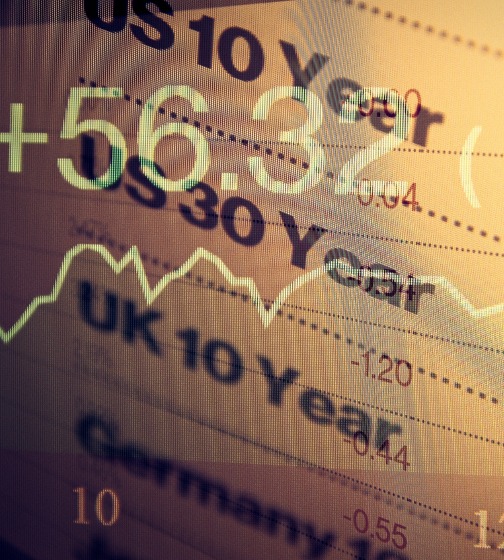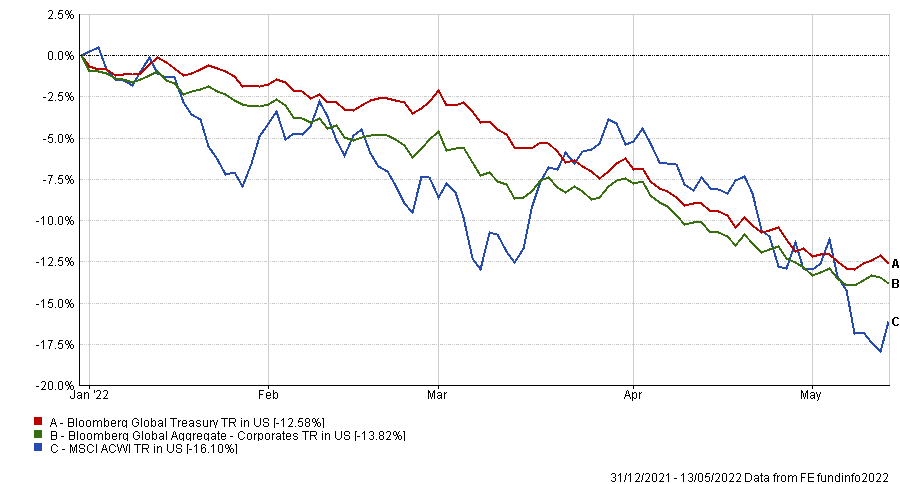Investors should be wary of dumping bonds even though the asset class has been caught up in the sell-off that has dominated the start of the 2022, fixed income managers have argued. 
Markets have been rattled over recent months by numerous concerns, including surging inflation, rising interest rates, worries about weaker economic growth and Russia’s invasion of Ukraine.
This has caused global equities to drop – the MSCI AC World index is currently down 16.1% (in US dollar terms) over 2022 so far. But investors have also become nervous in the bond market, with global treasuries falling 12.6% and corporate bonds down 13.8% over the same period.
Performance of asset classes in 2022 to date

Source: FE Analytics. Total return in US dollars between 1 Jan 2022 and 13 May 2022
Falling bond prices mean yields have risen but they remain low when compared with current inflation and to their history, meaning that not many investors are getting excited about fixed income at the moment.
Chris Iggo, chief investment officer for core investments at AXA Investment Managers, said the focus on relatively low yields should not mean investors overlook that bond prices are at multi-year lows.
“That means there is the potential for some interesting returns in the next year,” he added. “Bonds have sold off a lot and in previous bear market episodes, subsequent returns have been strong. So now is not the time to sell.”
One data point that Iggo highlighted is the weighted average price of bonds in fixed income indices: average prices have been well above 100 in recent years as interest rates fell below the coupon rates at which bonds were first issued.
“That is now reversing, and prices have fallen accordingly. What this means is that by either replicating a benchmark index or constructing a more concentrated portfolio, there is the opportunity to buy lots of bonds well below par,” he explained.
“On the assumption that most of them will redeem at 100, returns can be significant once the market turns. Pull-to-par, like compound interest, is one of the wonders of bond investing.”
For example, the average price of bonds in the Bank of America/ICE index has recently fallen to 90.6. Average prices have only fallen lower than this on a handful of occasions over the past 20 years – 2020’s initial Covid sell-off (low of 78), the growth fears in 2015 (low of 84), the 2008-09 global financial crisis (low of 55) and the recession after the Y2K slowdown (low of 75).
Iggo added: “Each time, 12-to-24-month price returns were subsequently very strong. Prices may go lower, but they won’t stay low. Yes, default risk is rising, but active stock selection means that at the portfolio level this risk can be mitigated.”
The strategist said investors should look beyond the fact that bond yields in many cases are below the rate of inflation.
This is because bond prices move towards 100 the closer they get to redemption (known as ‘pull to par’), which benefits returns at the index level. In addition, new bonds will be issued with higher coupons to reflect rising inflation and rates.
“If interest expectations start to ease back this will provide an additional push higher in prices,” Iggo said.
“The total return could significantly beat inflation over the next couple of years even if the yield-to-maturity (which represents the annualised total return over the remaining life of the bond) may not look as though that would be the case.”
Eoin Walsh, manager of the £1.6bn TwentyFour Dynamic Bond fund, added that another reason investors could be reluctant to allocate to fixed income is the rise in correlations between stocks and bonds.
Traditionally, the two asset classes have shown a negative correlation – when the stock market was selling off, investors would turn to ‘safe havens’ such as government bonds thereby pushing up their prices and vice versa.
However, equities and bonds have fallen together during 2022’s challenging start. “10-year US Treasuries have given losses of 10% year-to-date, which means the safe haven asset of choice for most investors has only inflicted more pain,” Walsh noted.
But he takes heart in signs that normal correlations are starting to return to the broad-based sell-off which has dominated 2022 so far.
Last week Treasuries rallied as equity markets sold off, even though the latest US inflation numbers were higher than the market was expecting.
Walsh attributed a number of reasons for this, including the higher yield on 10-year US Treasuries. It currently stands at 2.9%, which is “a more reasonable yield for investors” than the 1.5% it started the year at.
Added to this, the fear of substantial additional losses from Treasuries have abated. Yields are now reasonably above the Federal Reserve’s likely neutral rate of 2.5%, which offers comfort to bond investors, the TwentyFour manager said.
“There has also been a slight shift in the narrative, which is now focused on a potential recession rather than just inflation,” Walsh finished.
“There is an ongoing debate over whether the Fed would hike into a recession, and the answer probably depends on what kind of recession the US would be facing (would there be high or low unemployment, high or low default rates?).
“However, given the number of hikes already being priced in by the markets, we think Treasuries would likely provide a safe haven if growth turned negative. As asset managers begin to transition for late-cycle – as we currently are – this is also likely to lend further support to risk-off assets.”






